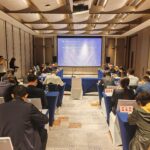Over the past five years, Chongqing has facilitated the creation of more than 3.48 million new urban jobs, allocated 14 billion yuan in employment subsidies, and issued 60 billion yuan in low-interest policy loans including “job stabilization loans.”
During a series of press conferences titled “High-Quality Completion of the ’14th Five-Year Plan’ and Writing the Chongqing Chapter of Chinese-style Modernization,” the human resources and social security system presented its report card for the “14th Five-Year Plan” period.
During the “14th Five-Year Plan” period, Chongqing focused on “expanding employment and increasing income, gathering talent and strengthening skills, implementing reforms and increasing efficiency, preventing risks and promoting harmony,” with the development of human resources and social security showing steady improvement and quality enhancement.
To make employment more satisfactory, Chongqing has continuously improved its employment priority policy system over the past five years, introducing 19 concrete measures across six areas including industrial-driven employment and entrepreneurship-driven employment. These efforts have steadily maintained and expanded employment, resulting in over 3.48 million new urban jobs created in five years. The average urban surveyed unemployment rate for the first four years was 5.4%, lower than the 5.5% target.
In terms of continuously helping enterprises overcome difficulties and stabilize and expand positions, Chongqing established a comprehensive support system including phased social insurance fee reductions and exemptions, unemployment insurance return for job stabilization, and employment and entrepreneurship subsidies. The city allocated 14 billion yuan in employment subsidy funds and issued 60 billion yuan in low-interest policy loans including “job stabilization loans.” It also innovatively established a risk compensation fund for entrepreneurial guarantee loans, reducing burdens for enterprises and supporting entrepreneurs, making the employment foundation more stable.
To continuously support key groups and build Chongqing into the preferred city for youth employment and entrepreneurship in western China, the city implemented an action plan for one million college graduates and other young people to stay or come to Chongqing for employment and entrepreneurship. It also launched a three-year action plan for migrant workers to find employment nearby, expanded the “doorstep” employment service network, and provided subsidized vocational skills training to 1.5 million people. These efforts helped 640,000 young people stay or come to Chongqing for employment and entrepreneurship, enabled 7.945 million migrant workers to find employment as desired, and helped 817,000 people lifted out of poverty secure stable employment.
In talent recruitment and cultivation, Chongqing expanded channels for precise talent recruitment over the past five years, iteratively upgraded talent attraction policies, and recruited over 10,000 outstanding engineers annually. Postdoctoral recruitment maintained above 1,000 people for four consecutive years. The city implemented special programs including the “Starry Sky” software talent program and the “Fifty Thousand Plan” for rural talent, explored salary system reforms in universities and research institutions, innovatively established a “directory + scoring” dual-channel talent evaluation mechanism, and through automatic system coding, talents can access corresponding category services.
Data shows that Chongqing’s professional technical talent pool reached 2.4 million people, an 18% increase compared to the end of the “13th Five-Year Plan” period. High-skilled talent grew to 1.795 million, a 72% increase compared to the end of the “13th Five-Year Plan” period, accounting for 32% of skilled talent and maintaining leading position in western China.



